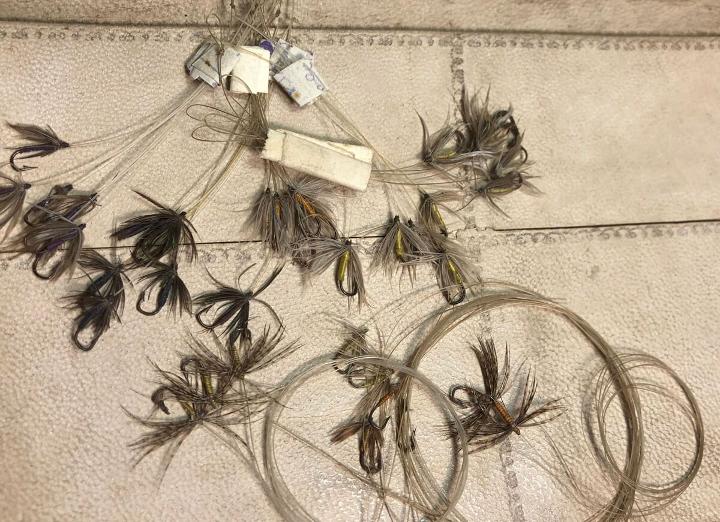If you read anything at all about fly fishing in Britain, you will have come across references to the North Country method, which most writers describe as fishing with spider patterns, and that is usually about as much detail as you get, before they dive in to telling you how to tie flies from their favourite section. But there is a lot more to the North country method than most people appreciate; I grew up with it as a way of fishing and it works just about anywhere, although I wouldn’t bet the farm on it as a way of catching bonefish. The North Country was once upon a time the counties of Westmorland, Cumberland, Durham, Yorkshire and Northumberland, but the borders and names have changed. Today, it it might be described as everything north of a line running east to west from the Humber estuary, along the River Wharfe and then westward across to the River Lune. The east and western borders are the coasts, while the northern limit is the Scottish border. There is nothing official about this definition, and if we were in a pub, there would be endless arguments about exactly where the southern limit lies and whether Sheffield is in or out, but you get the idea. Within this area there are about a dozen watersheds, including the Lune, the Cumbrian Derwent and Esk, the Eden, the Aln, the Coquet, the Tyne, the Wear, the Tees, the Yorkshire Esk, and the Ouse/Ure system, into which the Yorkshire Derwent, the Wharfe, the Nidd and the Swale drain.

None of these rivers are particularly large, so along most of their lengths a moderately capable caster could hit the far bank, and while some have slow, silty lower reaches, the one thing they all have in common is that they have stony bottoms for most of their lengths. Hatches tend to be sparse and although you do see mayfly, you will mostly see stoneflies, sedges, smuts, and almost inevitably these days, midges. Astonishing though it may seem to anyone who knows the area, the North country does have a few chalk streams, in the shape of Driffield west beck, Costa beck, and Cod beck. I do not know how the latter got its name, because there definitely aren’t any cod in it, nor even burbot, but after Cod it is called. Of all these, Driffield beck has the greatest reputation, and tickets to fish there cost a good deal, but when all is said and done, it is nothing more romantic than the upper reach of the river Hull—anyone who is familiar with the lower reach of the Hull will be astonished to hear that anything can survive in its upper stretches, let alone rise to a fly, but most surely they do.
Dry fly fishing is not what the North Country style is about, though, and many arguments were fought out in the pages of the angling press during the late nineteenth century to prove it. Virtually every one of these arguments revolved around the same point, and one which is crucial to the whole North country philosophy of fly fishing, which is that casts are not made to individual sighted fish, but instead the fly is dropped in likely spots as the angler works his or her way upstream. This approach drove the dry fly men crazy, but if if you have ever fished on a North Country river, you will appreciate that the hatches aren’t frequent enough to encourage a watch and wait strategy; a tactician who understands that there is very likely to be a trout in the eddy behind that rock over there, can hit the 150mm drag-free spot and strike on the instant is going to do rather better than someone who waits for the next rise, which might take a long time to happen.
As every Italian fisherman will understand, wild fish in freestone rivers have to live on their wits and food is scarce enough that they never reach the kind of population density that they can in alkaline water. So when a traditional North Country fisherman sets off to wade upstream, he uses a longish rod, ten foot, even ten foot six, and makes pick up and lay down casts (a method that used to be called whipping long ago), raising the rod tip as the fly drifts back towards him to maintain the tension on the line. When there is a dimple, he strikes; when there is a slight hesitation of the leader, he strikes; when the wind shifts slightly, he strikes; when a fox three hundred meters away breaks wind, he strikes; when his gut tells him, he strikes. One thing he does not do is to sit on a bench set on a perfectly cut lawn on a smooth river bank (there aren’t any) and the other thing he does not do is to false cast very much, because that scares the fish almost as much as it does on a chalk stream.
The old boys, all of them dead now, more the pity, stripped enough line off the reel at the beginning of the day to make their first cast and could be relied upon to have exactly the same length out at the end of the day. This way of doing things takes a bit of getting used to, but in the right circumstances, especially when you use spider patterns in the surface film, it can be dynamite. It is, of course, nymph or emerger fishing, depending on how far down you let the fly go, but since none of the old North country fishers understood what nymphs were, they can’t be said—as has been suggested recently—to have discovered nymphing. If they had done, it would have been amazing, but despite the fact that nymphs were identified in the seventeenth century, and had been illustrated in the eighteenth, right up to the beginning of the twentieth century anglers believed that the flies fish took fell on the water from the air, and so the North country spiders were tied to represent spinners and drowned duns. None of this matters to the fish, of course, because nobody teaches them any science.
Now that we have touched on the history of the North Country method, it might be worth looking into it a little more deeply. There are a couple of books on the subject worth reading if you want to explore further, but both are out of print: the first is A Handbook of North Country Trout Flies by Roger Fogg; the second is Fly Fishing: The North Country Tradition by Leslie Magee. You will notice the conspicuous absence of Robert Smith’s recent The North Country Fly: Yorkshire's Soft Hackle Tradition, the reason being that although Smith’s section on fly fishing methods isn’t too bad, the first half of the book is riddled with so many errors and assumptions that it is completely unreliable. As far as Italian readers are concerned, the worst assumption Smith makes is on page 3, where he writes: "In all probability, the earliest North Country patterns were imported to England by the Romans, and later adopted by both Christian monks and French stonemasons who (prior to the dissolution of the monasteries from 1536 to 1541), had established and inhabited the great monastic centres in the north from the XI and XII centuries”.
Smith enlarges enthusiastically on this theme, fantasising that pilgrims spread flies throughout the North Country and that the monasteries of the North then traded wool with continental Europe in part exchange for even more flies. “Included in this trade would have been the refining and adaptations of the existing ancient fly patterns, with new materials and dressings from continental Europe. And it is in these ancient fly patterns that the ancestry of the North Country fly originates”. If any of this was true, then the Italians could claim to be the ancestors of the North country tradition, which would be fantastic, but regrettably it is fable. For a start, the only evidence that the Romans ever fly fished is based on the interpretation of a single ambiguous reference by Martial—sure, Aelian mentioned fly fishing, but he was talking about the Macedonians, not the Romans. Second, although it is possible that Macedonian soldiers in the Roman army took flies with them on their travels (I speculated about that in The History of Fly Fishing), there is no evidence that they brought them to the north of England.
Third, there is no evidence that the monks in the north of England either fly fished, or that they ever traded goods for flies; on the contrary, they kept carp and other coarse fish in ponds, which they netted. Fourth, if the Valsesia method, which Smith picks up on, did manage to transfer itself to northern England, when wasn’t even widely known in Italy, it would be a miracle; but even if it did, it doesn’t explain why the North Country tackle and flies are so very different to the ancient Italian system. Finally, Robert Smith's title, The North Country Fly: Yorkshire’s Soft Hackle Tradition underlines the worst flaw in the book, which is that ignores the rest of the North country in favour of building a story around the River Wharfe and Yorkshire. This isn’t intended to be a review of Smith’s book, more a caution that it is completely unreliable from a historical point of view, because when you examine the evidence from a historian’s viewpoint, we don’t have the slightest idea about the history of fly fishing in the North country prior to the early XVIII century.
As far as the history after that date goes, we have many lists of flies in manuscript, beginning with one written in about 1712 by a William Lister. These manuscripts would be much more interesting if it weren’t for the fact that their authors copied so extensively from each other and from other manuscripts which have since been lost, including some which appear to have been sourced from outside the region; the reason why so many of these handwritten lists have survived being that there was a distinct lack of books about fly fishing in the north until comparatively late on, a circumstance which forced anglers to write patterns down by hand. Once upon a time there would have been many more manuscripts around than there are today, the survival of such things being in the order of 1%, depending on age and context. The first book on the North Country method, The North-Country Angler, was published in Leeds in 1786; it was was reprinted in 1789, 1800 and 1817, but it didn’t contain anything resembling a list of flies. Other early works on the subject included Alexander Mackintosh's The Driffield Angler, published circa 1806, and John Kirkbride's The Northern Angler, published in 1837, but important though they are in the North Country bibliography, neither contains much of interest to the North Country spider fisher. The real meat of the what most people think of today as the North Country bibliography began with John Jackson's The Practical Fly Fisher in 1854, continued with Thomas Pritt's Yorkshire Trout Flies in 1885 and reached its zenith in Brook and River Trouting by Harfield Henry Edmonds and Norman Nellist Lee in 1916. Other notable writers on the subject include Thomas Charleton, John Turton, William Chatto, Joseph Wells, Henry Wade, Francis Walbran, Michael Theakston, and William Sang, but if I start discussing that lot, this article will never get finished.
The most interesting part of the North Country tradition of fly fishing has to be the flies I have already mentioned, which are variously known as spider patterns, or more recently as soft hackles, thanks to Sylvester Nemes. However, neither of these names is really accurate, because there are plenty of flies tied with soft hackles that aren’t associated with the North Country, and many more which are called spiders, notably William Stewart’s patterns. A much better term would be game hackle flies, because the distinguishing feature of these North Country patterns is that they are tied with hackles taken from game birds, particularly the grey partridge, the woodcock, the snipe, the plover and the grouse, all of which are or were abundant in the north of England. Once you appreciate this nuance, it becomes easy to distinguish a North Country spider from one of Stewart’s spiders, because the Scots flies were tied with hackles from birds of little interest to shooters, like starling, landrail and dotterel. The one exception to the game hackle rule is the use of waterhen's wing, in North Country spiders, the waterhen hardly being a challenging item to shoot.
Today the custom is to tie these game hackle patterns very sparsely, with the bodies as thin as possible whether silk or dubbing is used, with a hackle wound once, or one and a half times at most. However, the old masters didn’t lay down any firm rules, and tied their flies to last. The result, as a friend once complained to me, hardly looks like any kind of fly at all, but believe me, they work, and they get better the more hackle the fish chew off. The chief problem with tying the patterns is getting game hackles small enough to use with size 14 and 16 hooks, because most feather dealers have trouble believing that anyone could be interested in a grey partridge hackle less than about 4cm long. Just about the only solution is to buy complete skins, because most feathers of the size required are found on the neck and these seldom, if ever find their way into economy bags of game bird feathers. Tied properly, a game hackle pattern looks like an unfinished piece of fluff, but in the water they work exceedingly well and I have fished them all over the world with great success. One of the most confusing things the North Country flies is that the majority of the early patterns were called by the local name for the insect they represented, with the inevitable result that many different artificials ended up being given similar names, and that there were frequent near duplications of patterns. To make matters worse, none of these local names had any kind of agreed spelling, and the North Country dialects used words which rarely made their way into dictionaries, so the spellings are all over the place.
Some time ago I became a consultant to the Oxford English Dictionary and have a serious interest in this topic, but two of the most common old words in the lists are bloa and watchet fly. As you will be aware, there are many North Country flies with the word ‘bloa’ in the name, and much rubbish has been written about the term by amateur writers, but it has been known for many years to have been derived from the English ‘blo’ and the Norse ‘blá’, which refer to a dark blue, similar to the fur on a mole’s back. The North Country had once been under Viking rule and so inherited the ‘blá’ form, which is seen in Scots as ‘blae’ and old Northern English as ‘bloa’. This makes it all the more interesting that some of the writers in the early northern manuscripts use the form ‘bloe’ which heavily implies that some of the patterns they copied down had a southern English origin. On the other hand, Watchit (which you will also see spelt Watchit and Watchett), generally means a pale blue colour; the usage of this word goes right back to Old French and it originally came from a type of garment. The problem is that when the words Bloa or Watchet were attached to a North Country pattern, they almost always applied to a tint of blue seen in the wing of the natural insect, rather than any colour used in the artificial, so few of the patterns have very much blue in them. The most obvious example of this is the Dark Watchet, which was probably an Iron Blue imitation.
All of this changed during the XIX century, as the old dialects began to die out, the North Country fly names started to be modernised, and fashions in fly tying altered, so flies like the Snipe Blo became the Snipe and Yellow, while others such as the Deel Cruik (or Deul Cruik, or Devil Crook) became the Woodcock and Yellow. It would have been so much easier if Charles Cotton had lived in Wensleydale and a couple of books had been published on the subject back in the seventeenth century, but then we would all have been denied a good deal of harmless fun trying to work it all out. Game hackles are only a small part of the North Country fly list, and there are many famous patterns which were tied with feathers taken from garden birds and farm yard fowl, including, for example, the Treacle Parkin, which is a relative of the Red Tag. The Treacle Parkin is a grayling fly and one of the defining features of the North Country fly lists is that they are full of grayling patterns, because the grayling used to be at least as common as brown trout in our rivers. This article is showing signs of going on for ever, so I suppose I had better finish, but one of the other types of fly you see in the lists are ‘Bustards’, which seem to have been a Cumbrian specialty to begin with. The one material these patterns never use is bustard—they are mostly tied with white hen hackle or owl—but they were named after large moths, which were called Bustards and which became active at dusk.
The patterns which follow were taken from Edmonds and Lee’s Brook and River Trouting, which, for all it was published in 1916, has a very fine list of mature North Country flies. I once fished with nothing but these four patterns for an entire season and did as well as anyone else; if you tie them on size 14 or 16 hooks you won’t go far wrong. The one piece of advice I have is that if you use relatively fine-wired hooks, then they will stay in the surface film much better (as an example the Partridge Trout Spider L3A/S specifically designed for spiders). There are occasions on which the fish can be maddeningly selective and if the patterns sinks even a centimetre, they will ignore it, while at other times, if the pattern doesn’t sink a centimetre they will ignore it, so if at first you don’t succeed, try a tiny bit deeper. Or shallower. Or just have lunch and look out for kingfishers.
Waterhen Bloa
Wings: hackled with a smoky grey feather from under coverts of a waterhen's wing (the darker side of the feather towards the head of the fly).
Body: yellow silk, dubbed with mole's fur.
Head: yellow silk.
Snipe and Purple
Wings: hackled with the dark feather from the marginal coverts of a Snipe’s wing.
Body: purple silk.
Head: purple silk.
Orange Partridge
Wings: Hackled with a brown mottled (not barred) feather from a partridge’s neck or back.
Body: orange silk, ribbed with about four turns of gold wire or tinsel.
Head: orange silk.
Yellow Partridge
Wings: hackled with a greyish feather barely tinged with brown, from a Partridge’s back.
Body: yellow silk.
Head: yellow silk.
Edmonds and Lee say this is a diptera imitation, but the fish rarely seem to think so.
Special thanks to Roberto Messori for the permission to reproduce this article
originally appeared on Fly Line Magazine issue 3/2016.












